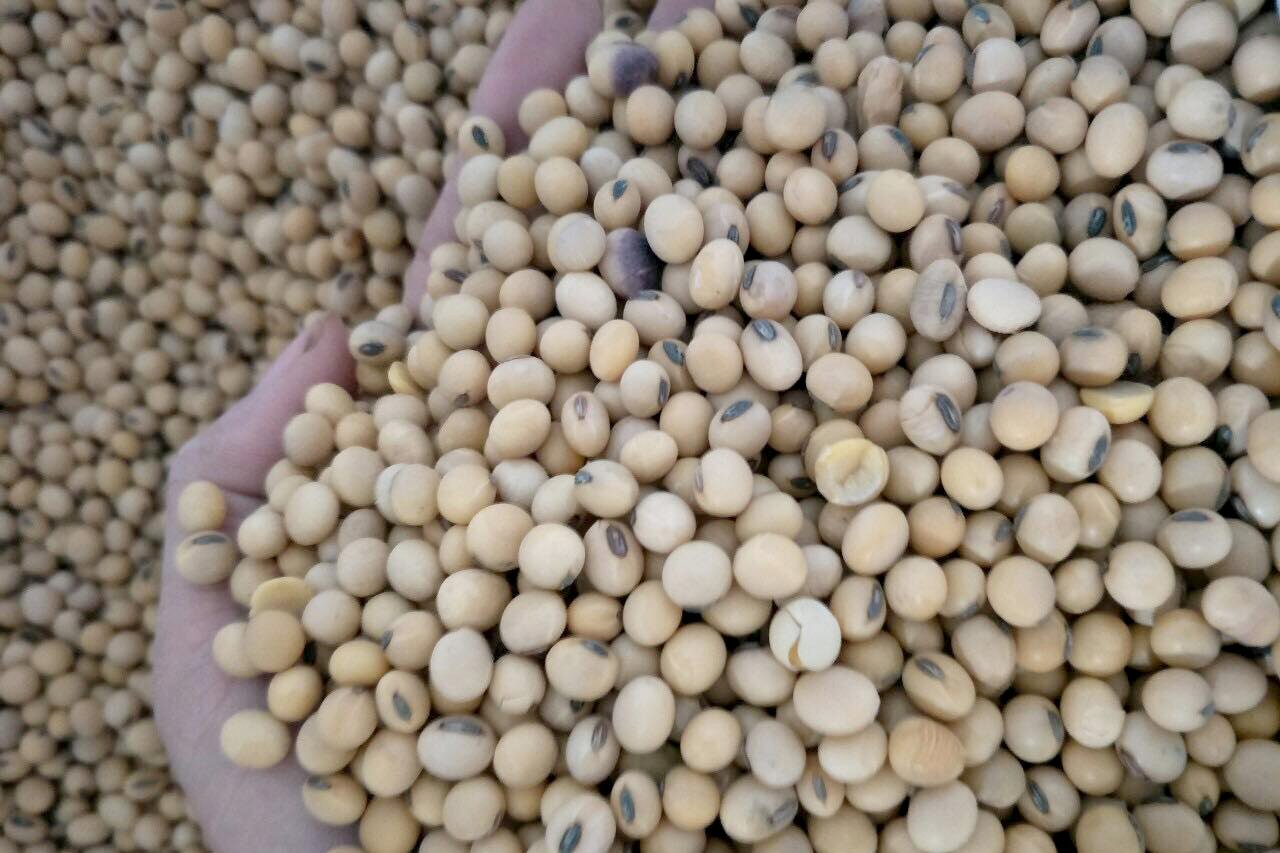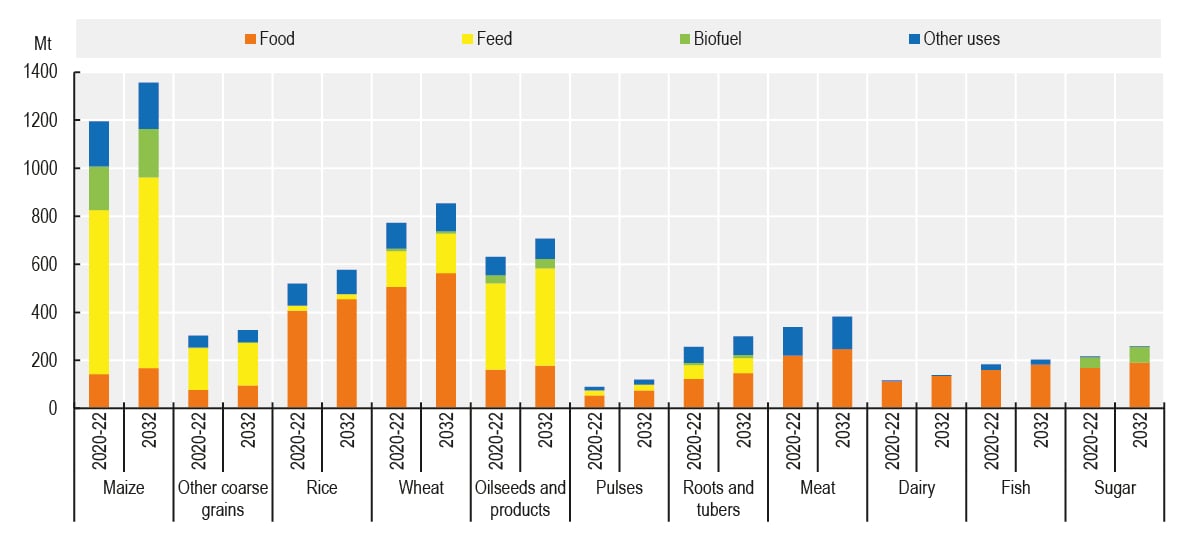May 22, 2025 | 13:36 GMT +7
May 22, 2025 | 13:36 GMT +7
Hotline: 0913.378.918
May 22, 2025 | 13:36 GMT +7
Hotline: 0913.378.918

Grain-based feed plays a major role in the world's agricultural industry. Photo: VAN.
Demands for food and non-food commodities are projected based on an assessment of the main driving factors: population dynamics, disposable income, prices, consumer preferences and policies. The use of grain-based feed as well as processed products such as protein meal, fish meal, cereal bran and other by-products in the livestock industry allows the industry to assess its net contribution to human nutrition and the potential impact of development on global food and nutrition security.
By 2032, increasing nutritional and energy demands stemming from global population growth will be the main drivers of the demand for agricultural commodities. The macroeconomic assumptions underlying the projections suggest a slower global population growth along with China's population decline.
Global economic growth will lead to increased per capita income in most countries. The inflation rate is expected to slow down in 2023 and over the next ten years. However, economic developments and their respective impacts will vary by country.
While the global reference price is expected to go down closer to the real value, it remains uncertain how the international price will serve as a reference for domestic consumer prices and the impact on consumption demands at the local level.
In addition, differences in population dynamics between countries and regions, differences in incomes, consumer preferences, and rapid urbanization in many emerging economies mean that consumption trends will also vary by country and region.
Social development and policy factors, along with risks, are likely to affect countries’ consumption trends to varying degrees. Growth and income distribution will continue to remain uneven across countries and regions.
For example, in low-income countries, where food occupies a large proportion of household expenditure, so income and food price shocks will be disproportionately larger. Preferences formed by local cultures and traditions will continue to lead to differences in demand for agricultural commodities across different regions. Health and sustainability concerns are expected to accelerate the process of shaping food demand in emerging affluent regions.
Food remains the most used among basic agricultural commodities, currently accounting for 49% of the consumption rate at the global level. But in recent decades, animal feed and fuel have increased in terms of use and importance. Notably, growth in the global production of animal products has called for a significantly higher allocation of forage crops, which now account for 26% of total global use.
On the other hand, biofuels and industrial applications currently consume approximately 8% of global crop production. As production of animal products increases globally in the period 2023 - 2032, growth in the use of non-food crops is expected to continue to outpace growth in food use because of intensifying livestock production and increasing demand for biofuels.

Main commodities used worldwide. Photo: OECD/FAO.
The use of agricultural commodities varies considerably by country and region. Most notably, the share of food use in Sub-Saharan Africa remains higher than in all other regions of the world, accounting for 69% of total agricultural commodity use at present, expected to increase to 71% by 2032. Population growth may have a larger impact on agriculture with commodity demand being higher than income growth, leading to a larger expansion in the consumption of staple foods compared to animal products in the region.
Regarding the distribution of agricultural commodities in North America, food only accounts for 26% of total use, less than the share of animal feed or biofuels.
Increased use of animal feed in agricultural commodities is within expectations for Latin America, the Caribbean, and the Near East and North Africa regions in the period 2023 - 2032, partly driven by the growth in production based on income and the domestic consumption of animal products, but more importantly, the growth of meat exports.
Translated by Samuel Pham
![Reducing emissions from rice fields: [2] Farmers’ commitment to the soil](https://t.ex-cdn.com/nongnghiepmoitruong.vn/608w/files/news/2025/05/05/dsc08881jpg-nongnghiep-140632.jpg)
(VAN) Clean rice cultivation model in Thuong Tan commune, Bac Tan Uyen district, is assisting local residents in achieving sustainable agriculture by substantially reducing costs, increasing productivity, and protecting the environment.

(VAN) At the conference to disseminate Resolution No. 68, AgriS introduced its digital agricultural ecosystem and reaffirmed its commitment to accompanying the Government in promoting private sector development and sustainable agriculture.

(VAN) 'Blue Ocean - Blue Foods' initiative is designed to restore marine ecosystems and establish sustainable livelihoods for local communities by cultivating a minimum of 1,000 hectares of cottonii seaweed in the first three years.
/2025/05/21/4642-3-112707_603.jpg)
(VAN) The V-SCOPE project has made direct contributions to three out of six pillars of the Comprehensive Strategic Partnership between Vietnam and Australia.

(VAN) Facing the threat of rabies spreading to the community, Gia Lai province urgently carries out measures to vaccinate dogs and cats on a large scale.

(VAN) Disease-free livestock farming not only protects livestock herds but also stabilizes production and livelihoods for many farmers in Tuyen Quang.

(VAN) Japan's grant aid project contributes to capacity building, promoting organic agricultural production, and fostering sustainable community development in Dong Thap province.